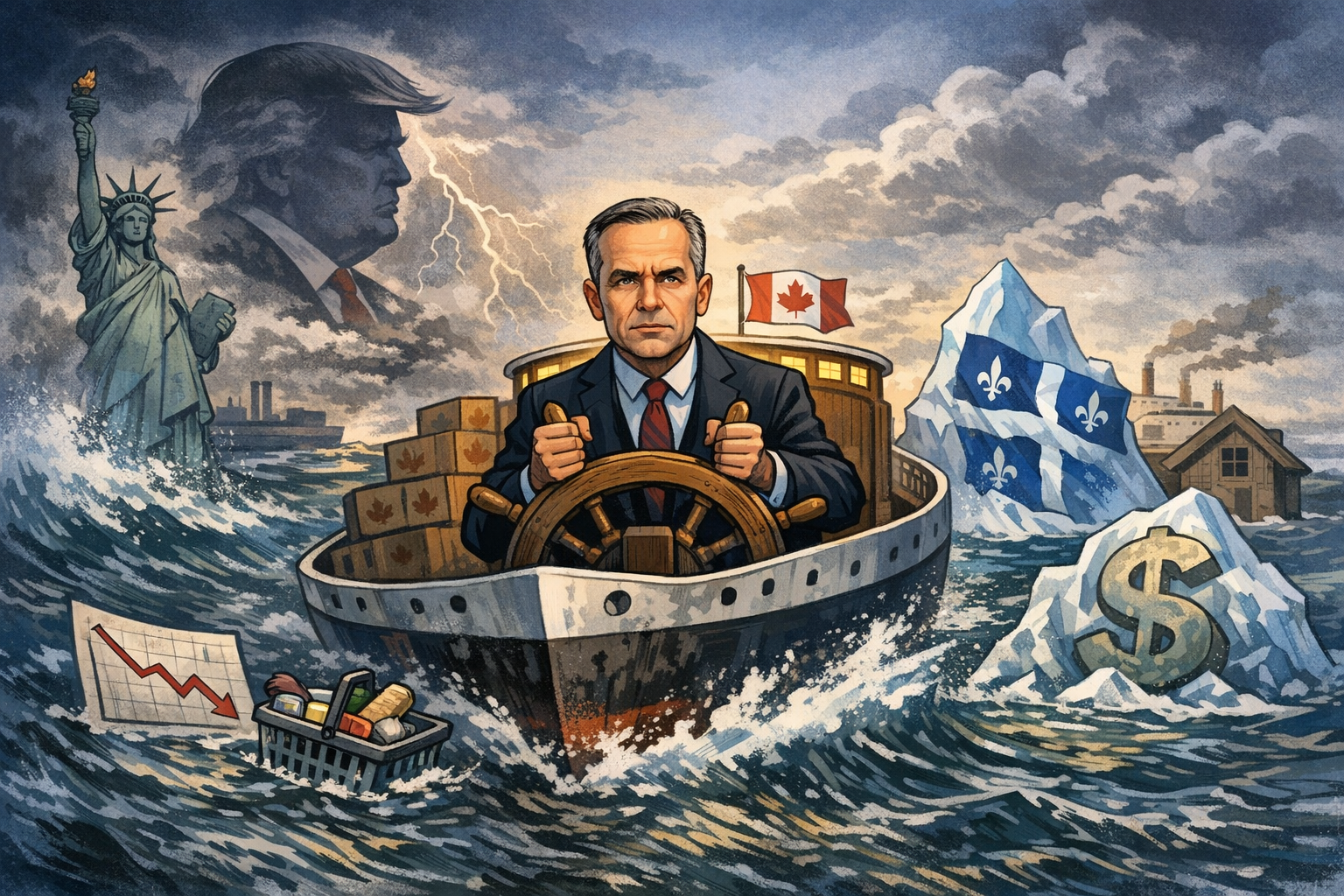PCs Hold Commanding Lead, But 1 in 4 PC Supporters Point to a Lack of Alternative for their Support of Doug Ford.
October 21, 2025
Doug Ford and the Progressive Conservatives remain the dominant political force in Ontario, commanding a solid lead over their rivals despite signs that a meaningful segment of their support is more circumstantial than enthusiastic.
Our latest survey of 1,000 eligible voters, conducted during a relatively quiet week in Ontario politics, finds the PCs holding at 51%, the Liberals ticking up slightly to 25%, and the NDP climbing to 15%, their highest share in months.
Beneath those steady toplines, however, the poll reveals important undercurrents about voter attitudes, particularly among Ford’s own base. One in four PC voters say they are supporting the PC Party not because of its record, but because they don’t see a better option. This quiet vulnerability comes as the Ontario Liberals search for a new leader and the NDP continues to struggle with visibility and relevance.
Vote Intention: PCs Maintain Strong Majority Support
If an election were held today, 51% of committed voters would support Doug Ford’s Progressive Conservatives, a one-point dip since mid-September. The Liberals inch up by one point to 25%, while the NDP climbs by three to reach 15%, marking their first upward movement since the spring. The Greens fall back slightly to 5%.
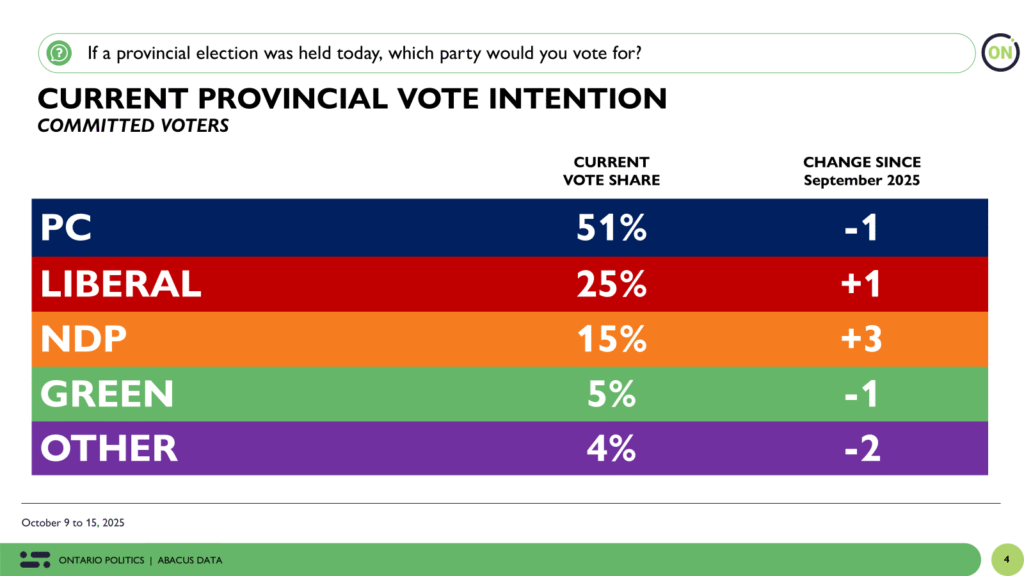
Ford’s 26-point lead over the Liberals mirrors last month’s results and signals the enduring stability of his coalition. But while top-line numbers appear rock-solid, the motivations behind that support merit closer examination.
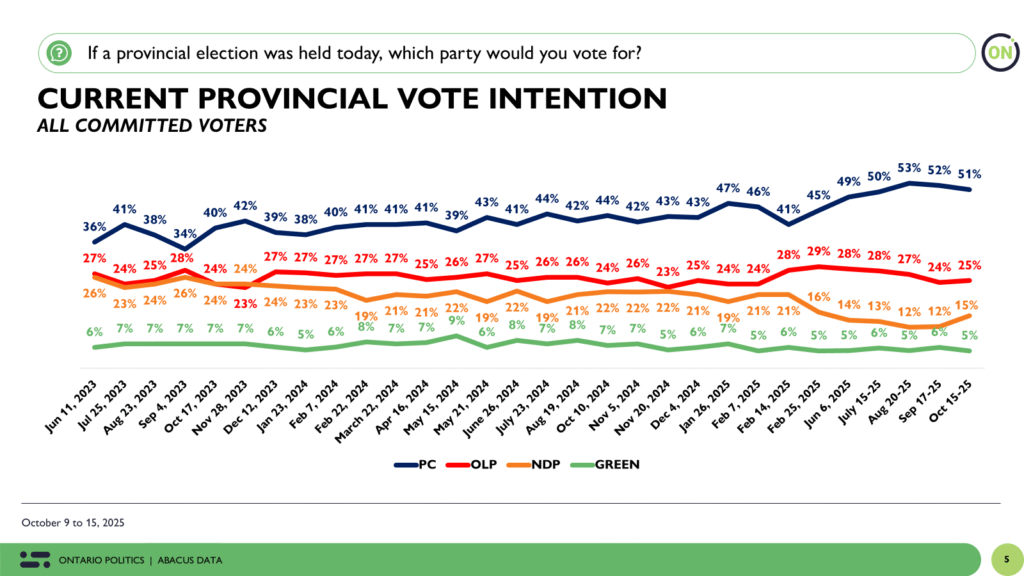
PCs Continue Regional and Demographic Dominance
Regionally, the PCs lead in every part of the province. In Toronto, they command 58%—a figure once unthinkable for a centre-right party in the city—compared to 26% for the Liberals and just 12% for the NDP. In the Greater Toronto and Hamilton Area (GTHA), the PCs lead 48% to the Liberals’ 32%, and they hold double-digit advantages in Southwestern and Eastern Ontario.
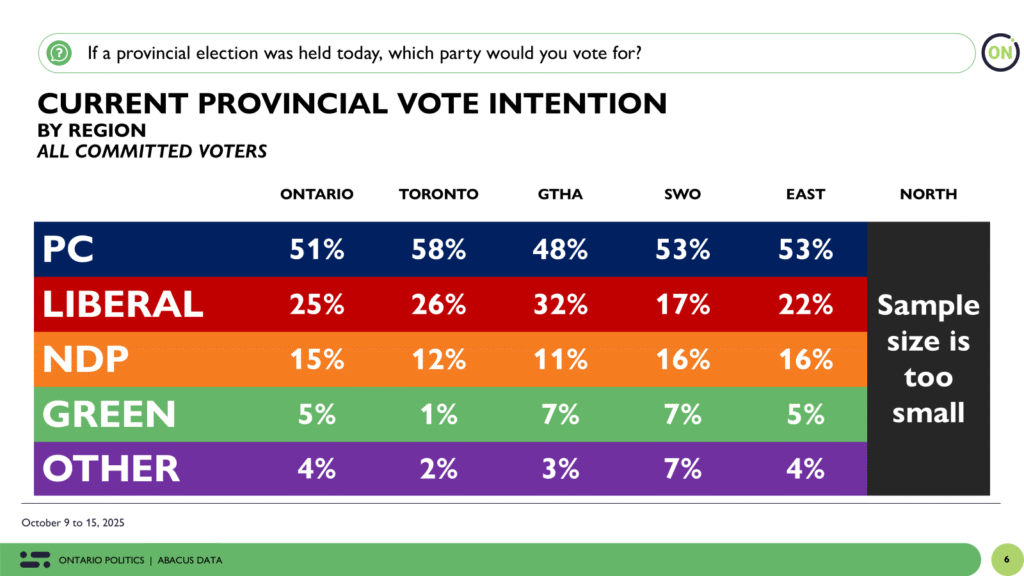
The demographic cuts reinforce this trend. Ford’s party leads among both men (54%) and women (49%), and across every age group, including younger voters aged 18 to 29, where the PCs still come out ahead at 40%, compared to 31% for the Liberals and 15% for the NDP.
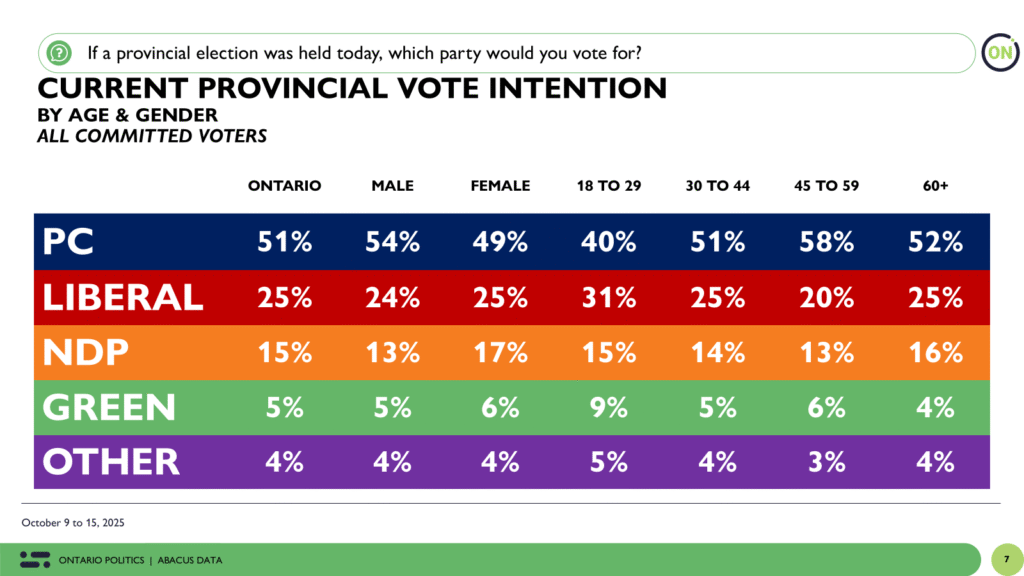
Approval Ratings: Still Positive, But Softening
Approval of the Ford government stands at 42%, a five-point drop from September, while disapproval has climbed to 33%, up two points. Although still in net positive territory (+9), this is the lowest approval Ford has seen since the beginning of the year.
This decline, though modest, reflects growing ambivalence. Fully 22% of Ontarians now say they neither approve nor disapprove—suggesting a reservoir of soft support or opposition hat could shift under different circumstances.

Leadership Impressions: Ford Leads, Crombie Slides Further
Doug Ford remains the most positively viewed political leader in the province, with 43% holding a favourable view and 35% unfavourable, yielding a net impression of +8.
Bonnie Crombie, now in a caretaker role, continues to slide: only 25% of voters view her positively, while 35% view her negatively—a net -10. Marit Stiles and Mike Schreiner remain less defined to most voters, with net scores of -1 and -2, respectively.
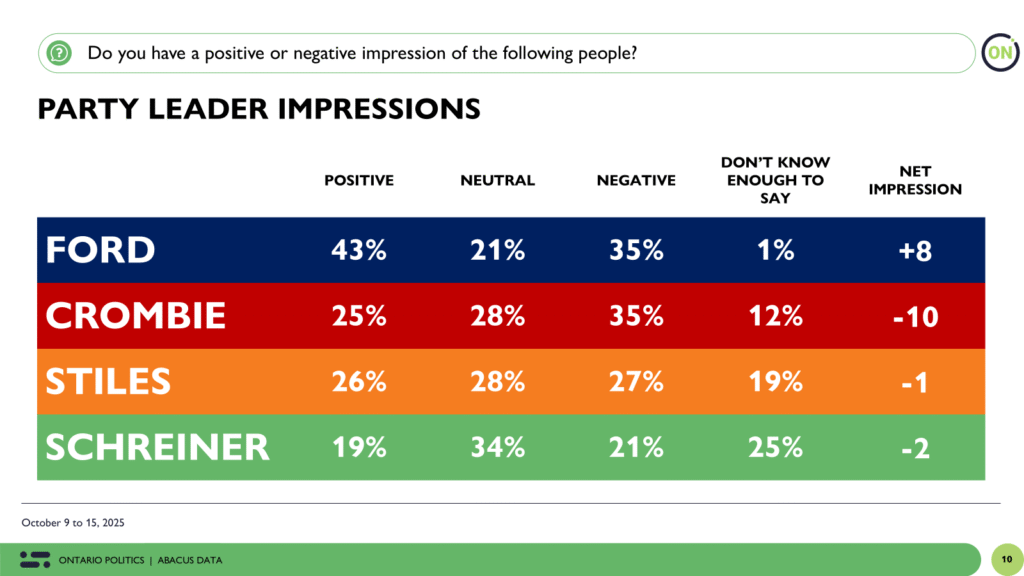
Preferred Premier: Ford Still Leads, But Gaps Emerging
Doug Ford remains the preferred choice for Premier for 46% of Ontarians. Crombie trails at 18%, Stiles at 12%, and Schreiner at 4%.
Notably, Ford leads in every region and age group except among 18-to-29-year-olds, where his lead narrows significantly: 37% prefer Ford compared to 22% for Crombie and 15% for Stiles. Among women, Ford holds a ten-point lead (42% vs. 32% for all others combined), while among men, he leads by a commanding 30 points.
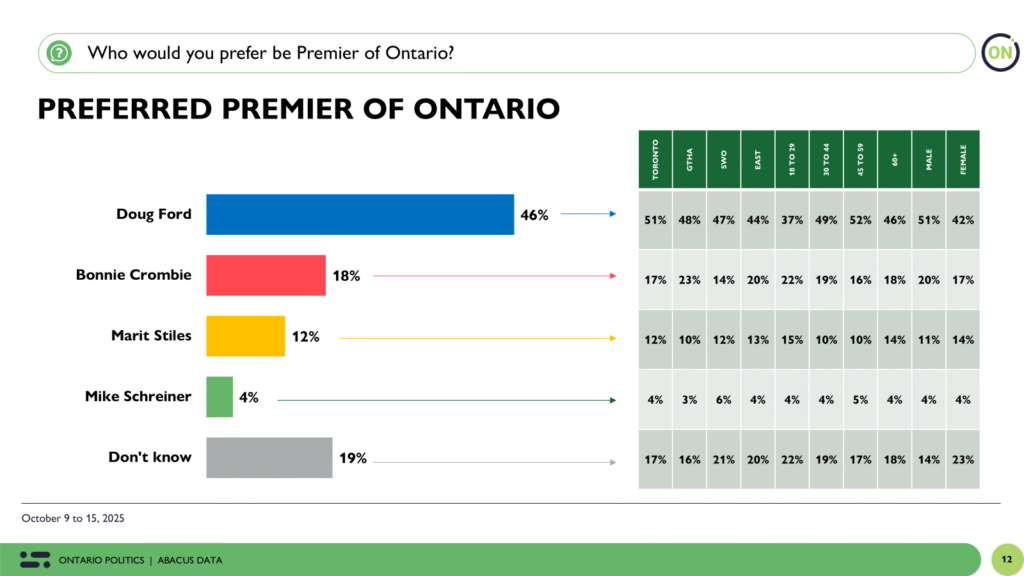
A Quarter of PC Voters Back Ford by Default
One of the most revealing findings this month is from a new question we asked this wave. Among those who say they would vote PC, 25% say their choice is driven by the lack of a better alternative, not by Ford’s performance or personal loyalty.
This segment—representing about 7% of the full electorate—is the soft underbelly of Ford’s support. They’re not necessarily happy with the government, but they see no credible opposition worth taking a risk on.
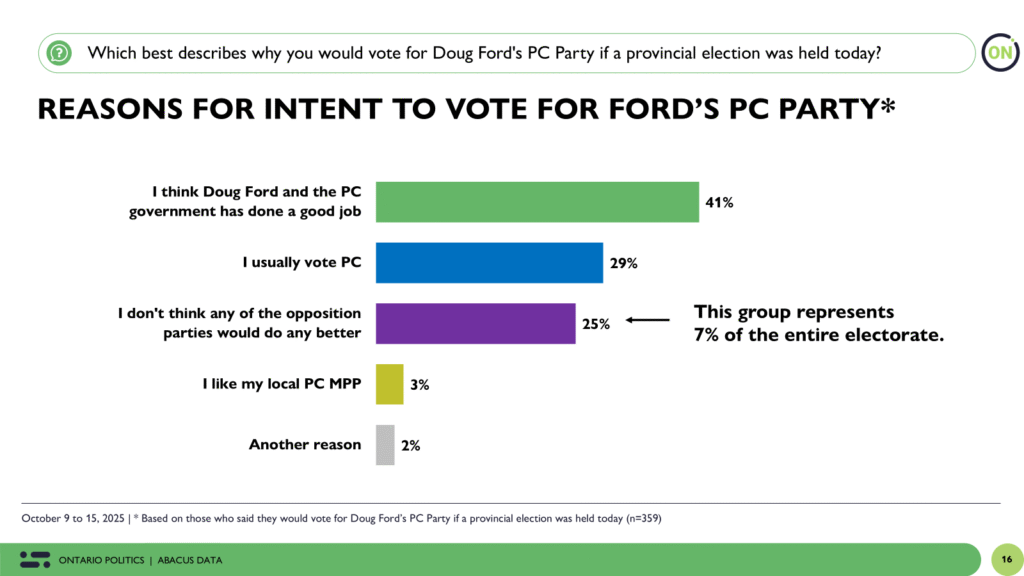
The implications are clear: if the Ontario Liberals can select a leader with credibility and appeal, or if the NDP can finally break through with a more resonant message and brand, there is room for movement. But that if has been the central challenge for both parties for several years.
Perceptions of Ford’s Impact: A Mixed Bag
New questions added to this wave also offer deeper insights into how Ontarians view the Ford government’s impact. While 43% believe the Premier has made Ontario “better” at standing up for the province, and 26% credit him with making the province more attractive for business, most issues show tepid or negative evaluations.
- Only 19% say Ford has made positive impacts on reducing uncertainty for Ontario workers.
- Just 14% think he’s improved health care.
- Only 10% believe he’s improved affordability or the availability of housing.
In all cases, most either think he hasn’t made much impact or has made things worse.
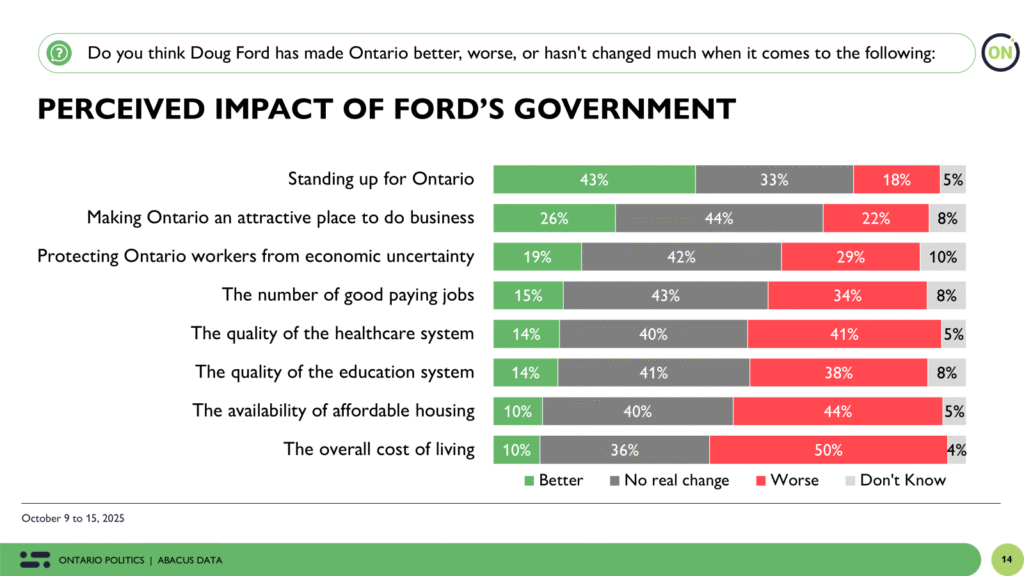
Even among PC voters, enthusiasm is muted: 55% say the government has had no real impact on housing, and 51% say the same about affordability.
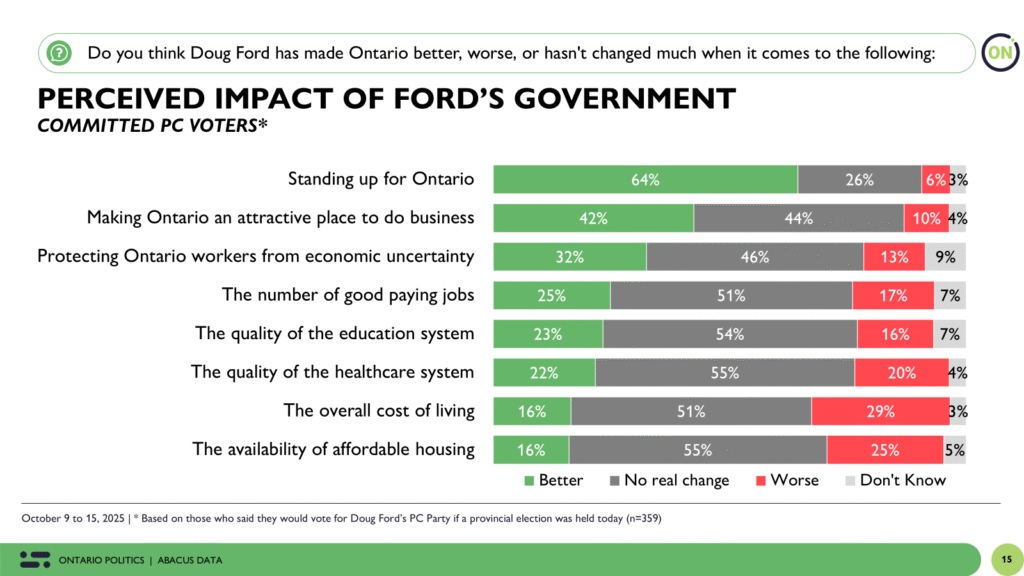
What stands out is how much of the government’s goodwill likely stems from its posture toward the Trump administration. The perception that Ford is “standing up for Ontario” appears to anchor support at a time when economic and public service outcomes are receiving lukewarm or negative reviews. Absent this dynamic, it’s likely that both the government’s and Ford’s personal approval ratings would be under far heavier pressure.
The Upshot
Doug Ford continues to dominate the political landscape in Ontario—buoyed by a fractured opposition and a broad but partially disengaged support base. The latest numbers offer both reassurance and warning signs for the Premier: his coalition remains large and cross-demographic, but much of it is conditional.
One in four PC supporters might vote differently if a more compelling option were on offer. And among the public overall, there’s growing uncertainty about whether the Ford government is meaningfully improving life in the province.
For the Ontario Liberals, this is both a challenge and an opportunity. A new leader will need to quickly establish credibility and communicate a clear alternative vision. For the NDP, the data underscores the urgency of relevance: with just 12% naming Marit Stiles as their preferred Premier, but some signs their prospects have improved this wave, the party risks becoming stuck with little traction with the public.
The path to dislodging Ford isn’t blocked, but it will require more than criticism. It will take a compelling, relevant and credible alternative.
Methodology
The survey was conducted with 1,000 eligible voters in Ontario from October 9 to 15, 2025.
A random sample of panelists were invited to complete the survey from a set of partner panels based on the Lucid exchange platform. These partners are typically double opt-in survey panels, blended to manage out potential skews in the data from a single source.
The margin of error for a comparable probability-based random sample of the same size is +/- 3.1%, 19 times out of 20.
The data were weighted according to census data to ensure the sample matched Ontario’s population according to age, gender, education, and region. Totals may not add to 100 due to rounding.
This survey was paid for by Abacus Data Inc.
Abacus Data follows the CRIC Public Opinion Research Standards and Disclosure Requirements. Learn more: https://canadianresearchinsightscouncil.ca/standards
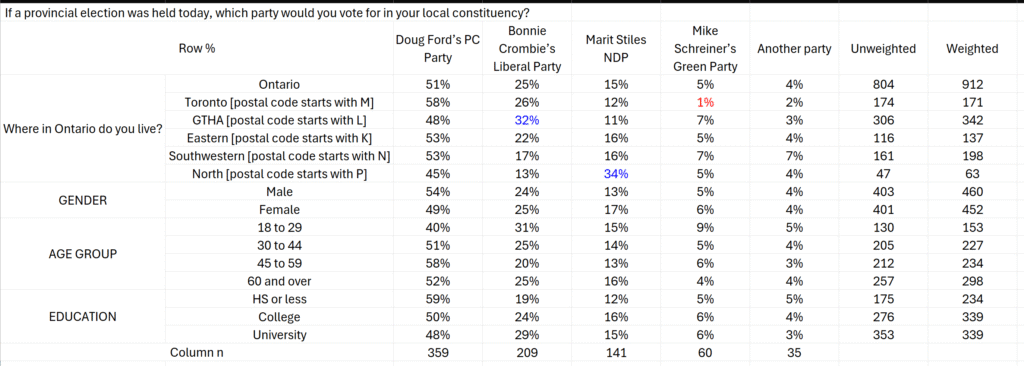
ABOUT ABACUS DATA
We are Canada’s most sought-after, influential, and impactful polling and market research firm. We are hired by many of North America’s most respected and influential brands and organizations.
We use the latest technology, sound science, and deep experience to generate top-flight research-based advice to our clients. We offer global research capacity with a strong focus on customer service, attention to detail, and exceptional value.
And we are growing throughout all parts of Canada and the United States and have capacity for new clients who want high quality research insights with enlightened hospitality.
Our record speaks for itself: we were one of the most accurate pollsters conducting research during the 2021 Canadian election following up on our outstanding record in the 2019, 2015, and 2011 federal elections.
Contact us with any questions.
Find out more about how we can help your organization by downloading our corporate profile and service offering.



